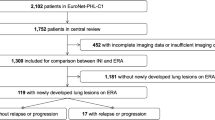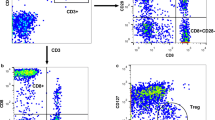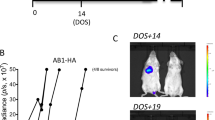Abstract
Objectives
The halo sign refers to a zone of ground-glass attenuation surrounding a pulmonary nodule. Pulmonary metastatic nodules exhibiting a halo sign are seen mainly in hypervascular tumours. We describe the appearance of a halo sign following treatment of adoptive transfer of autologous tumour-infiltrating lymphocytes (TIL) to melanoma patients with lung metastases.
Methods
The study included 29 melanoma patients with pulmonary metastases who received TIL therapy. Pre- and post-treatment chest CTs were retrospectively reviewed for the presence of a halo sign and its correlation with therapeutic response.
Results
A pulmonary halo sign was not seen in any pre-treatment CT. It was observed in four of 12 patients who responded to the therapy but not in those who failed to respond. Significant differences were found between response ratio in patients in whom post-TIL halo sign appeared compared with those without the halo sign (p = 0.02).
Conclusions
The appearance of a CT halo sign in melanoma with lung metastases following TIL therapy may indicate antitumoral effect and a good response to therapy. Our findings emphasize the importance of applying new assessment criteria for immunological anticancer therapies.
Key Points
• Tumour-infiltrating lymphocytes (TIL) in melanoma patients is a promising novel immunotherapy
• Post-therapy pulmonary halo sign appeared in one-third of TIL responders
• Pulmonary halo sign may serve as an imaging marker for antitumoral activity



Similar content being viewed by others
Abbreviations
- ACT:
-
adoptive cell therapy
- TIL:
-
tumour-infiltrating lymphocytes
References
Dreno B, Nguyen JM, Khammari A, Pandolfino MC, Tessier MH, Bercegeay S, Cassidanius A, Lemarre P, Billaudel S, Labarriere N, Jotereau F (2002) Randomized trial of adoptive transfer of melanoma tumor-infiltrating lymphocytes as adjuvant therapy for stage III melanoma. Cancer Immunol Immunother 51:539–546
Rosenberg SA, Dudley ME (2009) Adoptive cell therapy for the treatment of patients with metastatic melanoma. Curr Opin Immunol 21:233–240
Lee YR, Choi YW, Lee KJ, Jeon SC, Park CK, Heo JN (2005) CT halo sign: the spectrum of pulmonary diseases. Br J Radiol 78:862–865
Primack SL, Hartman TE, Lee KS, Muller NL (1994) Pulmonary nodules and the CT halo sign. Radiology 190:513–515
Kaneria SS, Tarkin J, Williams G, Bain G, Quigley M (2012) Case report: the CT halo sign: a rare manifestation of squamous cell carcinoma of the lung. Clin Radiol 67:613–615
Okita R, Yamashita M, Nakata M, Teramoto N, Bessho A, Mogami H (2005) Multiple ground-glass opacity in metastasis of malignant melanoma diagnosed by lung biopsy. Ann Thorac Surg 79:e1–e2
Shapira-Frommer R, Schachter J (2012) Adoptive immunotherapy of advanced melanoma. Curr Treat Options in Oncol 13:340–353
Besser MJ, Shapira-Frommer R, Treves AJ, Zippel D, Itzhaki O, Hershkovitz L, Levy D, Kubi A, Hovav E, Chermoshniuk N, Shalmon B, Hardan I, Catane R, Markel G, Apter S, Ben-Nun A, Kuchuk I, Shimoni A, Nagler A, Schachter J (2010) Clinical responses in a phase II study using adoptive transfer of short-term cultured tumor infiltration lymphocytes in metastatic melanoma patients. Clin Cancer Res 16:2646–2655
Eisenhauer EA, Therasse P, Bogaerts J, Schwartz LH, Sargent D, Ford R, Dancey J, Arbuck S, Gwyther S, Mooney M, Rubinstein L, Shankar L, Dodd L, Kaplan R, Lacombe D, Verweij J (2009) New response evaluation criteria in solid tumours: revised RECIST guideline (version 1.1). Eur J Cancer 45:228–247
Therasse P, Arbuck SG, Eisenhauer EA, Wanders J, Kaplan RS, Rubinstein L, Verweij J, Van GM, van Oosterom AT, Christian MC, Gwyther SG (2000) New guidelines to evaluate the response to treatment in solid tumors. European Organization for Research and Treatment of Cancer, National Cancer Institute of the United States, National Cancer Institute of Canada. J Natl Cancer Inst 92:205–216
Marten K, Rummeny EJ, Engelke C (2004) The CT halo: a new sign in active pulmonary sarcoidosis. Br J Radiol 77:1042–1045
Cole DJ, Taubenberger JK, Pockaj BA, Yannelli JR, Carter C, Carrasquillo J, Leitman S, Steinberg SM, Rosenberg SA, Yang YC (1994) Histopathological analysis of metastatic melanoma deposits in patients receiving adoptive immunotherapy with tumor-infiltrating lymphocytes. Cancer Immunol Immunother 38:299–303
Fisher B, Packard BS, Read EJ, Carrasquillo JA, Carter CS, Topalian SL, Yang JC, Yolles P, Larson SM, Rosenberg SA (1989) Tumor localization of adoptively transferred indium-111 labeled tumor infiltrating lymphocytes in patients with metastatic melanoma. J Clin Oncol 7:250–261
Griffith KD, Read EJ, Carrasquillo JA, Carter CS, Yang JC, Fisher B, Aebersold P, Packard BS, Yu MY, Rosenberg SA (1989) In vivo distribution of adoptively transferred indium-111-labeled tumor infiltrating lymphocytes and peripheral blood lymphocytes in patients with metastatic melanoma. J Natl Cancer Inst 81:1709–1717
Pockaj BA, Sherry RM, Wei JP, Yannelli JR, Carter CS, Leitman SF, Carasquillo JA, Steinberg SM, Rosenberg SA, Yang JC (1994) Localization of 111indium-labeled tumor infiltrating lymphocytes to tumor in patients receiving adoptive immunotherapy. Augmentation with cyclophosphamide and correlation with response. Cancer 73:1731–1737
Zhou J, Dudley ME, Rosenberg SA, Robbins PF (2005) Persistence of multiple tumor-specific T-cell clones is associated with complete tumor regression in a melanoma patient receiving adoptive cell transfer therapy. J Immunother 28:53–62
Hoos A, Eggermont AM, Janetzki S, Hodi FS, Ibrahim R, Anderson A, Humphrey R, Blumenstein B, Old L, Wolchok J (2010) Improved endpoints for cancer immunotherapy trials. J Natl Cancer Inst 102:1388–1397
Acknowledgments
The scientific guarantor of this publication is Prof. Sara Apter. The authors of this manuscript declare no relationships with any companies whose products or services may be related to the subject matter of the article. The authors state that this work has not received any funding. No complex statistical methods were necessary for this paper. Institutional review board approval was obtained. Written informed consent was waived by the institutional review board. Methodology: retrospective, observational, performed at one institution.
Author information
Authors and Affiliations
Corresponding author
Rights and permissions
About this article
Cite this article
Shrot, S., Schachter, J., Shapira-Frommer, R. et al. CT halo sign as an imaging marker for response to adoptive cell therapy in metastatic melanoma with pulmonary metastases. Eur Radiol 24, 1251–1256 (2014). https://doi.org/10.1007/s00330-014-3129-6
Received:
Revised:
Accepted:
Published:
Issue Date:
DOI: https://doi.org/10.1007/s00330-014-3129-6




